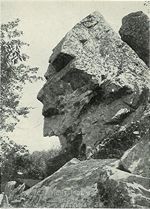Massasoit
[4] Massasoit's people had been seriously weakened by a series of epidemics and were vulnerable to attacks by the Narragansetts, and he formed an alliance with the colonists at Plymouth Colony for defense against them.
At the time of the pilgrims' arrival in Plymouth, the realm of the Wampanoag, also known as the Pokanokets, included parts of Rhode Island and much of southeastern Massachusetts.
Samoset was a minor Abenaki sachem (sagamore) who hailed from the Muscongus Bay area of Maine,[7] and he learned to speak English from fishermen who plied those waters.
He had learned that a group of influential Massachusett warriors intended to destroy both the Wessagusset and Plymouth colonies, and he warned the Pilgrims in time.
Massasoit sold a tract of land 14 miles square to Myles Standish and others of Duxbury in 1649 to alleviate tension and maintain the peace.
Roger Williams fled the Massachusetts Bay Colony to avoid arrest and deportation for religious reasons and stayed the winter of 1635–36 with Massasoit, who gave him land along the Seekonk River the following spring.
Governor Winslow advised Williams to move his settlement to the other side of the river because his current location was within the bounds of Plymouth Colony.
A statue of Massasoit by sculptor Cyrus E. Dallin stands near Plymouth Rock, with others outside the Utah State Capitol building, on the campus of Brigham Young University, at the Springville Museum of Art in Springville, Utah, and in Kansas City, Missouri at the corner of Main Street and Emanuel Cleaver II Blvd.


